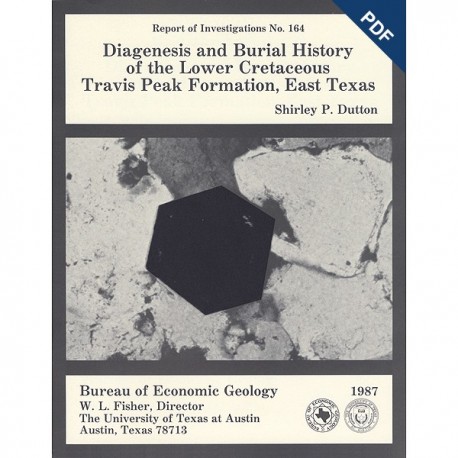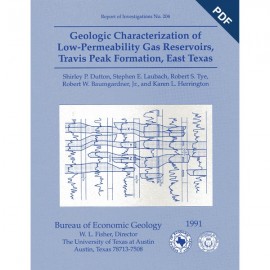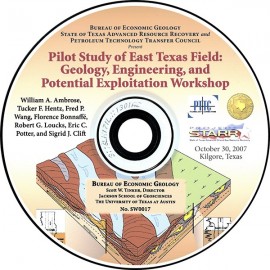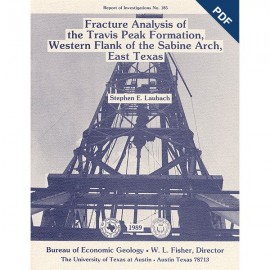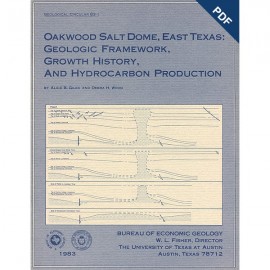Reports of Investigations
-
Books & Reports
- Reports of Investigations
- Guidebooks
- Udden Series
- Geological Circulars
- Down To Earth
- Atlases of Major Oil and Gas Reservoirs
- Texas Memorial Museum Publications
- Environmental Geologic Atlas of the Texas Coastal Zone
- Mineral Resource Circulars
- Other Reports
- Seminars and Workshops
- Handbooks
- Submerged Lands of Texas
- Symposia
- Annual Reports
- Open File Reports
-
Maps & Cross Sections
- Thematic Maps
- Miscellaneous Maps, Charts & Sections
- Geologic Atlas of Texas
- STATEMAP Project Maps
- Geologic Quadrangle Maps
- Cross Sections
- Highway Geology Map
- Energy and Mineral Resource Maps
- Shoreline Change and Other Posters
- Wilcox Group, East Texas, Geological / Hydrological Folios
- Bouguer Gravity Atlas of Texas
- River Basin Regional Studies
- Featured Maps
- Posters
- Teachers & the Public
-
Geological Society Publications
- Gulf Coast Association of Geological Societies
- Alabama Geological Society
- Austin Geological Society
- Corpus Christi Geological Society
- Houston Geological Society
- Lafayette Geological Society
- Mississippi Geological Society
- New Orleans Geological Society
- South Texas Geological Society
- GCS SEPM Publications
- Historic BEG & UT Series
Diagenesis and Burial History of the...Travis Peak Formation, East Texas. Digital Download
RI0164D
For a print version: RI0164.
RI0164D. Diagenesis and Burial History of the Lower Cretaceous Travis Peak Formation, East Texas, by S. P. Dutton. 58 p., 43 figs., 11 tables, 1987. doi.org/10.23867/RI0164D. Downloadable PDF.
To purchase this publication in book format, please order RI0164.
ABSTRACT
Sandstone in the Travis Peak (Hosston) Formation has been extensively modified by burial diagenesis. Permeability in much of the formation has been reduced to less than 0.1 md as a result of compaction, extensive precipitation of authigenic minerals, and minor pressure solution. Thin zones of higher porosity and permeability occur mainly near the top of the formation; porosity and permeability decrease with depth below the top. The Travis Peak Formation in East Texas is approximately 2,000 ft (600 m) thick; the top of the formation ranges from 5,800 ft (1,770 m) to 9,400 ft (2,870 m) below sea level.
Travis Peak sandstone is fine-grained to very fine grained quartzarenite and subarkose having an average composition of Q95F4R1. Plagioclase feldspar is more abundant than orthoclase, and chert and low-rank metamorphic rock fragments are the most common lithic components.
The first authigenic cement to precipitate was illite, which coated detrital grains with tangentially oriented crystals. Dolomite cement also formed shortly after deposition at about 77°F (25°C) from a fluid with a δ18O composition of 0‰, probably seawater. Next, extensive quartz cement averaging 17 percent of the rock volume in well-sorted sandstone, occluded much of the primary porosity. Quartz cement is most abundant in the lower Travis Peak, in well-connected sandstone beds that were deposited in braided streams. Oxygen-isotopic composition of quartz overgrowths indicates that they precipitated from meteoric fluids at temperatures of 130° to 165°F (55° to 75°C). These temperatures occur at depths of 3,000 to 5,000 ft (900 to 1,500 m).
Dissolution of orthoclase and albitization of plagioclase followed quartz cementation and occurred before movement of the Sabine Uplift in the mid-Cretaceous. An abrupt loss of orthoclase occurs at 1,200 ft (365 m) below the top of the Travis Peak, and albitization is more extensive deeper in the formation. Illite (a second generation), chlorite, and ankerite precipitated after feldspar diagenesis; these late authigenic phases incorporate ferrous iron released by thermal reduction of iron compounds. Ankerite was derived primarily from early dolomite cement, but it incorporated some light carbon from maturation of organic matter and radiogenic strontium from feldspar dissolution. During ankerite precipitation, the oxygen-isotopic composition of pore fluids evolved from -4 to+2"/00 (SMOW); +24/00 is the average composition of Travis Peak water now.
Oil from Jurassic source rocks migrated into Travis Peak reservoirs in the Late Cretaceous. Later deasphalting of the oil filled much of the remaining porosity in some zones near the top of the formation with reservoir bitumen.
Keywords: East Texas, hydrocarbon resources, sandstone diagenesis, tight gas sandstone, Travis Peak Formation
CONTENTS
ABSTRACT
INTRODUCTION
DEPOSITIONAL HISTORY
METHODS
TRAVIS PEAK COMPOSITION
Framework grains
Feldspar
Plagioclase
Orthoclase
Rock fragments
Nonessential constituents
Provenance
Matrix
Cements
Authigenic quartz
Authigenic clay minerals
Authigenic carbonate cements
Major element composition
Isotopic composition
Feldspar
Other authigenic minerals
Solid hydrocarbons
Porosity
Pre-cement porosity
Permeability
Travis Peak fluids
ORGANIC GEOCHEMISTRY
Detrital organic matter
Source-rock quality
Thermal maturity
Reservoir bitumen
Elemental analysis
Chromatography
Travis Peak oil
Source of Travis Peak oil
BURIAL AND THERMAL HISTORY
Burial-history curves
Thermal history
Time-temperature index
INTERPRETATION OF DIAGENETIC HISTORY
lllite rims
Calcite cement
Dolomite cement
Quartz overgrowths
Cementation conditions
Paleohydrology
Variations in quartz cementation
Feldspar albitization and dissolution
Orthoclase dissolution
Albitization
Feldspar distribution
Development of secondary porosity
Authigenic clays
Ankerite
Hydrocarbon migration
Comparison with diagenesis in other Gulf Coast Mesozoic and Tertiary sandstones
CONCLUSIONS
ACKNOWLEDGMENTS
REFERENCES
Figures
1. Location of study area and wells from which Travis Peak cores were taken
2. Regional tectonic map of the central Gulf coastal province
3. Core control plotted against depth below the top of the Travis Peak
4. Stratigraphic nomenclature, East Texas Basin
5. Paleodip·oriented stratigraphic cross section A-A'
6. Core description of Prairie Mast No. 1A well
7. Core description of Clayton Williams Sam Hughes No. 1 well
8. Classification of 255 Travis Peak sandstone samples
9. Plagioclase volume as a function of depth below the top of the Travis Peak
10. SEM photograph of internal albite overgrowths
11. Plagioclase composition as a function of depth below the top of the Travis Peak
12. Orthoclase volume as a function of depth below the top of the Travis Peak
13. Paleogeologic map of the Early Cretaceous (Coahuilan)
14. Relation between total volume of cement and depth below the top of the Travis Peak
15. Frequency of observed sequences of major cements in Travis Peak sandstones
16. Photomicrograph of quartzarenite and SEM photograph of interlocking quartz overgrowths
17. Photomicrograph of primary and secondary pores and euhedral quartz overgrowths and SEM photograph of euhedral quartz overgrowths
18. Plot of δ18O of whole-rock quartz versus percent quartz overgrowths of total quartz
19. Plots of δ18O of whole-rock quartz versus percent quartz overgrowths of total quartz in samples from the upper part of the formationand samples from deeper in the formation
20. SEM photograph of authigenic illite fibers and albite
21. SEM photographs of thick illite cutans and clay cutan with authigenic illite
22. SEM photograph of authigenic chlorite
23. Photomicrograph of dolomite and ankerite cements
24. Chemical composition of carbonate cements
25. Plot of dolomite cement volume with depth below the top of the Travis Peak
26. Back-scattered electron image of dolomite and ankerite cements
27. Plot of ankerite cement volume with depth below the top of the Travis Peak
28. Plot of O13C versus δ18O composition of carbonate cements
29. Plot of reservoir bitumen volume with depth below the top of the Travis Peak
30. Photomicrograph of reservoir bitumen in primary porosity
31. Rippled sandstone with reservoir bitumen highlighting ripple faces
32. Plot of primary porosity with depth below the top of the Travis Peak
33. Plot of secondary porosity with depth below the top of the Travis Peak
34. Plot of porosimeter porosity with depth below the top of the Travis Peak
35. Inverse relationship between quartz cement volume and unstressed permeability in matrix-free sandstone
36. Inverse relationship between total cement volume and unstressed permeability in matrix-free sandstone
37. Plot of permeability with depth in the Travis Peak
38. Organic matter types classified by hydrogen and oxygen indices
39. Gas chromatographs of C15+ saturate fraction of hydrocarbons extracted by dichloromethane from reservoir bitumen, Chapel Hill field, Smith County
40. Gas chromatographs of Travis Peak oil, Chapel Hill field, Smith County
41. Burial-history curves for the tops of the Travis Peak, Cotton Valley, Bossier, and Smackover Formations in Ashland S.F.O.T. No. 1 and Sun D. O. Caudle No. 2 wells
42. Burial-history curve for the Ashland S.F.O.T. No. 1 well showing when major diagenetic events may have occurred
43. Locus of possible water temperatures and δ18O compositions for authigenic quartz, ankerite, and dolomite
Tables
1. Travis Peak cores used in this study
2. Isotopic analyses of quartz
3. Isotopic analyses of carbonate cements
4. Strontium isotopic analyses
5. Composition of Travis Peak water
6. Values of weight percent total organic carbon, relative amounts of the major kerogen types, and average vitrinite reflectance of Travis Peak shale samples
7. Results of total organic carbon analyses and pyrolysis
8. Elemental analysis data of reservoir bitumen extracted from Travis Peak sandstones
9. Geochemical analyses of extractable fraction of reservoir bitumen from Travis Peak sandstones
10. Geochemical analyses of Travis Peak crude oil
11. Calculated time-temperature indices and corresponding vitrinite reflectance values
Citation
Dutton, S. P., 1987, Diagenesis and Burial History of the Lower Cretaceous Travis Peak Formation, East Texas: The University of Texas at Austin, Bureau of Economic Geology, Report of Investigations No. 164, 58 p.
